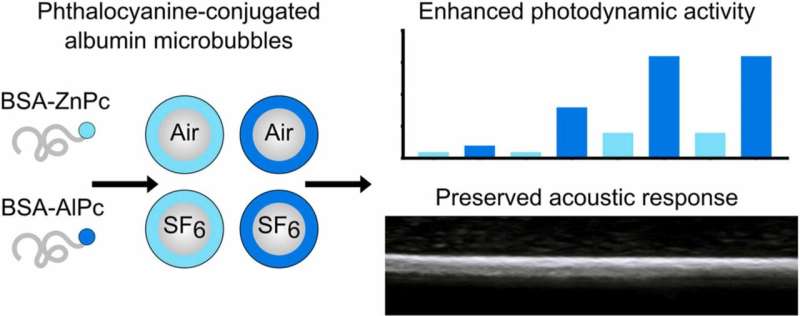Graphical abstract. Credit: Colloids and Surfaces B: Biointerfaces (2022). DOI: 10.1016/j.colsurfb.2022.112856
Scientists from Skoltech, MIPT, Prokhorov General Physics Institute of RAS, and a number of other research centers have shown microbubbles made of a protein called albumin to be effective vehicles for the delivery of photodynamic agents—drugs used in an advanced anti-cancer therapy that avoids many of the side effects associated with chemo- and radiation therapy. The findings are reported in Colloids and Surfaces B: Biointerfaces.
"Photodynamic therapy involves injecting a photosensitizing compound into the bloodstream and illuminating the tumor with light whose wavelength matches the compound, either through the skin or with an endoscope. After light energy is absorbed by the sensitizing agent, this gives rise to free radicals and an aggressive form of oxygen, which kill off cells in a very focused manner in the region exposed to light," the study's principal investigator, Professor Dmitry Gorin of Skoltech Photonics, said.
The lead author of the paper, Skoltech MSc graduate Roman Barmin, said, "What we did in this study is we showed on two popular photosensitizing agents that binding them with albumin, a bovine serum protein, results in their greater photoactivity, and whipping up the protein-drug conjugate into bubbles results in an even greater efficiency boost. This could be used to advance photodynamic cancer therapy."
The team used two commercial photosensitizing agents in the experiment, demonstrating covalent attachment of albumin for zinc phthalocyanine and electrostatic binding for aluminum phthalocyanine. The former is a clinically approved agent for photodynamic therapy, the latter is under clinical trials. "Whipping up" air bubbles actually involved exposing the phthalocyanine-albumin solution to ultrasound at an appropriate frequency and temperature.
"While microbubble delivery is, in general, a popular approach, this study is the first to use albumin bubbles in the context of photodynamic therapy and to work with the two phthalocyanines we considered," Barmin noted. "The idea behind microbubble delivery is that the shell of an air bubble can densely pack the molecules of photodynamic agents, and bubbles can be conveniently 'popped' by medical ultrasound in a controlled manner to release the drug."
Tests indicated that agent delivery to cells was successful. "Our next goal is a deeper understanding of microbubble-cell interactions to enhance therapeutic performance," Gorin added.
After studying microbubble properties, the team came to the conclusion that microbubbles conjugated with photodynamic agents have an improved physicochemical properties profile: The bubbles retain the same mean diameter as their phthalocyanine-free counterparts (used in ultrasound imaging), which is favorable for controlling their performance, and at the same time bubble concentration and storage stability are higher.
"The next question was: Will microbubbles increase the efficiency of the photodynamic agents they deliver?" Barmin said. "Our colleagues from Prokhorov General Physics Institute have developed a technique using a red blood cell suspension to test just that. The result was clear: For both agents, the phthalocyanine-albumin complex proved more effective than plain phthalocyanines, and microbubble delivery further boosted drug photoactivity. This results from the the dense molecule packing in the microbubble shell."
Photodynamic cancer therapy is one of the ways in which both microbubbles and ultrasound are leaving the domain of strictly diagnostic medical technology and finding applications in treatment.
More information: Roman A. Barmin et al, Albumin microbubbles conjugated with zinc and aluminum phthalocyanine dyes for enhanced photodynamic activity, Colloids and Surfaces B: Biointerfaces (2022). DOI: 10.1016/j.colsurfb.2022.112856
Provided by Skolkovo Institute of Science and Technology
























